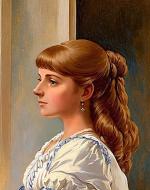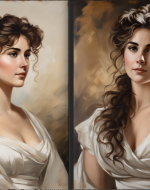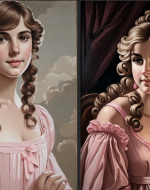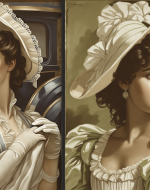Created by Molly Jordan on Mon, 11/06/2023 - 16:31
Description:
I set out to see how accurate new AI technology could be in re-creating Regency style, or Regency era, portraiture. I thought the combination of new technology and work from the Regency era was an interesting contrast that I wanted to test. I’ve worked with AI before to create portraits, but none of them have been from a style or period, so this offered a challenge to make not only portraits using AI but also as accurate to the timeframe as I could be. I’ve used sites such as Artbreeder and Midjourney before, but Artbreeder focuses mostly on faces, and I wanted backgrounds and clothing because that’s the style of most Regency portraits. In Regency era portraiture, we see people usually from the chest up and positioned in front of a backdrop, which Artbreeder could not make for me consistently. I thought about using Midjourney, a very powerful AI site, but its strengths rely heavily on aesthetic and consistently generated art with minimal effort; however, it lacks a lot of the refinement and control technology that Playgroundai offers. Midjourney also isn’t free. I found Playgroundai when searching for new sites to use, and although it was a learning curve, it was relatively simple to use and free. You can input an image as a reference, and then from your prompt, the AI will take the image and change it based on your prompt guidelines. Playgroundai also has a function called in-painting, which is where you can use AI to change elements of a piece that you’ve already created. Both tools were helpful when I wanted to change the elements of a portrait.
My exhibit itself starts with a self-portrait to place myself into the Regency era. From there, I exhibited two of my favorite options of images I created for each of the Bennet sisters from the novel Pride and Prejudice (1813). I have arranged the case from oldest to youngest, starting with Jane and ending with Lydia. I thought it was important to show different representations of these characters because there have been so many adaptations of Jane Austen's novels, and I recognize that how readers imagine these characters is subjective. I wanted to give viewers options. All the images below were created based on different reference images from film adaptations of Pride and Prejudice so that I could get a more authentic version of each sister.
Fig. 1. Self-portrait in Regency style, created by Molly Jordan with AI prompt "grainy Victorian oil paint portrait of a woman with middle-parted bangs leaning on a white wall wearing a regency-era blue dress and a yellow background," Playgroundai, version 8, 22 Sept. 2023. Before attempting to make portraits for the Jane Austen characters, I wanted to begin by making myself a Regency-style self-portrait, much like the silhouette portraits we made in class at Skidmore's IdeaLab. My goal was to learn a new platform, Playgroundai, and get used to the creation process with this new site. I originally used an image of myself as a base, then developed and edited my prompts to generate an image closest to what I wanted. I think overall in my collection, this image came out as the closest to accurate Regency-era portraiture because of the image's closeness to the style of oil painting of the time. This image took me the longest by far because I was trying to learn a new program, but I was also very concerned about creating an image that looked like it could have come from the era. I struggle with historical accuracy in the rest of my images, and I wanted at least to make one example of a historically accurate image. Portraiture is important to the Jane Austen novels about courting and romance as well as wealth and status; the color and quality of the portraits become someone's legacy because people didn't have photography to represent them, so representing myself in the period accurately was important to me.
Fig. 2. Jane Bennet, created by Molly Jordan with AI prompt "Victorian oil painting style portrait of a plain woman not wearing makeup with a blonde bun and curled bangs and from the waist up sitting in the living room wearing a simple blue dress", "aged Regency style oil paint portrait of a young woman with messy bangs and hair up in a messy bun with a white gown that covers the chest from the waist up," Playgroundai, versions 4, version 3, 11 Oct. 2023. Both of these images are based upon the 2005 film adaptation of Pride and Prejudice, but the first image of version 4 is based on an image of the actress Rosamund Pike who plays Jane Bennet in that film adaptation, while the second, version 3, is based on Keira Knightley who plays Elizabeth Bennet in that adaptation. In version 4, I liked how the image portrayed an older and more mature-looking young woman which is how Austen characterizes Jane, and she also is the beauty of the family that adheres to standards for women at the time in a way that her sister Elizabeth is not. Jane is trusting, patient, sensitive, and looking for true love, which ultimately leads her to fall for Charles Bingley and believe that he loves her even though he has disappeared from her life after they create a connection. Version 4, I think, shows those key traits of her personality. Version 3 shows how Jane is also an older sister and thought to be a representation of Austen's older sister, Cassandra, whom Austen loved; Jane's maturity and role as the oldest and the one who is shown off most at parties come through more in this image. The only problem I had during this creation process was the AI program's challenges with hands and arms. Sometimes hands would appear out of nowhere in places they shouldn’t be; arms would be shortened into just hands or hands would have more than five fingers on them. This is why most of my images have the hands cut out of the image, but you can see elements of what I’m talking about in version 4 of Jane Bennet. She has two hands that look like they have five fingers on them, but there is a random elbow or knob that her left hand seems to be caressing. I tried my best to remove it, but I couldn’t get a better image.
Fig. 3. Elizabeth Bennet, created by Molly Jordan with AI prompt "aged Regency style oil paint portrait of a young woman with messy bangs and hair up in a messy bun with a white gown that covers the chest from the waist up", Playgroundai, versions 2, 4, 10 Oct. 2023. Both of these images are originally based on the 2005 adaptation of Pride and Prejudice starring Keira Knightley as Elizabeth Bennet, but they are loosely based on the image and allowed for the AI to take more creative control. I knew I wanted to use an image of Elizabeth dressed up like she would be to go to a ball, because Regency era portraiture often portrayed women in their best gowns, and I wanted to stay true to that tradition. I had a difficult time with the images I found and ultimately set the AI to generate an image loosely based on the still I had from the 2005 version, but allowed for the AI to do most of the generating. The outcomes are version two and version four. I think these images are beautiful, but I think they represent a woman who looks more modern than the Regency era. Though the style of her dress is period accurate, her face and makeup look too perfect and idealized to be Elizabeth Bennet. Although we get very few facial descriptions in Austen, we know that Elizabeth Bennet is not the beauty of the family, but she's still a very handsome young woman. She is also characterized as not wanting to adhere to standards from another time, but having a strong moral compass and understanding of Regency society, and I wish these traits came through more in her portraits. To me, these images are more closely linked to the present day than the Regency era. This was something I struggled with when creating people. AI often creates skinny and conventionally attractive or idealized faces and bodies. It only creates beautiful images; there is even a box that says “exclude from image” that defaults to “ugly, deformed, noisy, distorted” as keywords. These defaults are all elements that AI doesn't want in their generated images, so this program exclude bodies that are considered ugly, fat, and disabled unless you specifically ask for that trait. Another thing I struggled with in this process was creating images that looked realistic to the Regency era. Even putting "Regency era" in my prompts, I would still get distinctly Victorian images, or elements of the piece that looked modern, such as makeup and hairstyles.
Fig. 4. Mary Bennet, created by Molly Jordan with AI prompt "Victorian oil painting portrait of a plain girl with and plain dress and apron hair in a bun and glasses and no makeup", Playgroundai, version 3, 4, 7 Nov. 2023. These two images of Mary Bennett are based on Talulah Riley, who plays Mary in the 2005 film adaptation of Pride and Prejudice, and Lucy Briers, who plays her in the 1995 BBC mini-series. Although the image I used to create both of these is from the 2005 film adaptation, my prompts draw inspiration from the 1995 version of Mary, which I thought was more true to her characterization in Austen's novel. Briers's Mary Bennet wears glasses, which I included in version 4, but the plain dark colors and apron are from the 2005 version. My favorite things about these two images are how dark the background is and how plain her clothes are. Mary is the middle child of the Bennet sisters. Jane and Elizabeth, the oldest two, are close to one another and Lydia and Kitty, the two youngest, are also closest to one another, leaving Mary alone. She's also neglected because she is considered the only "plain" member of the family, forced to get attention through her reading, piano playing , and singing. Although she enjoys books and reading, she is still not taken seriously by her family, and I wanted her portrait to show her as the middle child who doesn't stand out as much as her sisters. Mary also doesn't particularly care about her appearance, which is reflected in the dark colored clothes she's wearing and her hair being pulled back unceremoniously. The muted colors and dark tones of her portrait were added afterward by me and are meant to represent her social standing. Although Mary does not marry in the novel, Austen revealed later that Mary eventually settled for a clerk, which is not an uncomfortable lifestyle, but is much different to that of her older sisters and is shown in the quality of her portrait. Much like the portraits of the Austen family members who did not marry or obtain a large amount of wealth in their lives, Mary in her portrait lacks color and detail, showing that she is of a lower social ranking than her other siblings who are in color and have more detail.
Fig. 5. Kitty Bennet, created by Molly Jordan with AI prompt "Regency-style oil paint portrait of a plain girl with simple curled hair over one shoulder with a pink dress with puffy sleeves", Playgroundai, versions 2, 5, 7 Nov. 2023. Although Kitty Bennet is not the youngest member of the Bennets, in all the adaptations of Pride and Prejudice she is seen as the least mature and the most easily swayed by other members of her family, especially Lydia. So, for her portrait, I wanted her to appear as the youngest overall. After Lydia is married, Austen describes the older Bennet sisters as "reforming" Kitty, making her a better person in the eyes of the family and the reader without the influence of Lydia. I wanted to manifest this change in the portraits by creating a very innocent young-looking woman, with long curls and a pink dress with frills and bows. I also employed a slightly less saturated color palette to emphasize that although at the end of the novel Kitty seems reformed (Austen later reveals that she will marry a clergyman), through marriage, she is still not of the same social class as Jane and Elizabeth. I drew inspiration from the portraits of the Austen family that we saw, particularly of Austen's brothers James, Francis, and Charles, all of whom joined branches of the military and had respectable positions but were not as wealthy as their brother Edward, adopted by the Knight family. The brothers' portraits were either done in black-and-white or painted with a muted or less saturated color palette, which I tried to copy for Kitty.
Fig. 6. Lydia Bennet, created by Molly Jordan with AI prompt, "aged Victorian England regency style oil paint portrait of a young woman with bangs and hair up in curls under a large white hat with a white gown with blue stripes and white gloves that cover the chest from the waist up", "regency-style oil paint portrait of a plain girl with curls bangs and hair over one shoulder with a white and green dress with puffy sleeves", versions 5, 7, 11 Nov. 2023. Both the images I used as a basis for Lydia Bennet are from the 2005 adaptation of Pride and Prejudice. Jenna Malone, who plays Lydia Bennet in the adaptation, is continuously dressed in bonnets, hats, and frills that allow for a more eccentric, if not showy, youngest child who is always looking for male attention. Lydia as a protagonist is solely focused on the idea of marriage, but particularly male attention, which makes sense because at the beginning of the novel she is 15, turning 16 by the time she's married. Knowing Lydia could be seen as a villainess because she is selfish and brings scandal upon the Bennet family, we can understand her actions in the context that she is a young teenager with a mother figure who is solely focused on getting her daughters married. I wanted the portraits not only to represent Lydia Bennet as an attention-seeking character but also as a young woman desperate to look older and show off so that she can get the attention she seeks, which is why she looks older than some of her other sisters. We can see this in the facial expression of version 5, where she looks dismissive and proud, two character traits exemplified after she's married to Mr. Wickham. Her attention-seeking manifests itself infrills, bows, and large hats. I again altered the color palette to make it monochromatic, which shows her relatively lower social status. As the wife of an officer who is an incisive gambler, she is described as living a life where she is constantly asking her other sisters for money. When thinking about doing Lydia's portrait ,I almost wanted to do a simple silhouette because silhouettes were less expensive than a miniature portrait and would therefore fit with Lydia's social status, but I decided on a portrait to fit with the rest of the exhibit.







